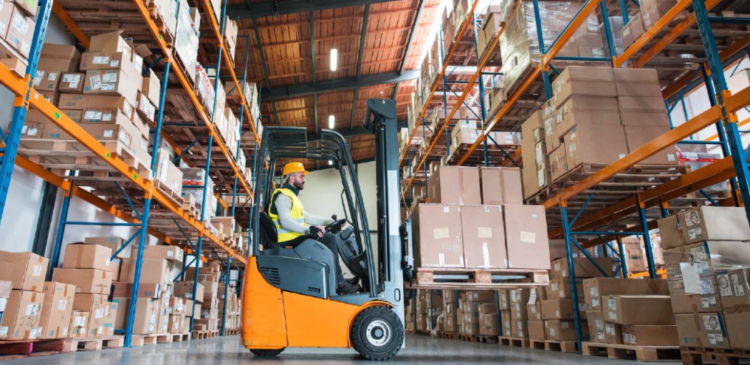A piggyback forklift is a type of forklift that can lift, load and transport materials in the same way as a standard one. For those unfamiliar with what a piggyback does, it is simply a device that attaches to the backside of another machine. In this article, you’ll learn about the top five benefits of using a piggyback forklift.
The benefits of using a piggyback forklift are many. Often, these machines can be used for jobs requiring a crane if not for the lifting power and reach of their boom. Piggyback forklifts also have a high capacity, making them ideal for heavy-duty tasks. They are also more economical than other forklifts because they can do what two or more machines would do at once. Lets explore more benefits of piggyback forklifts!
Benefits of Using a Piggyback Forklift
A piggyback forklift is a type of forklift that is used to transport goods on a pallet or in a container. The piggyback forklift can move goods from one location to another or load and unload vehicles.
The piggyback forklift is a versatile piece of equipment used in various applications. Piggyback forklifts are often used in warehouses and factories to move goods around. They can also be used in retail settings to load and unload vehicles.
Piggyback forklifts are available in a variety of sizes and configurations. The size of the piggyback forklift will determine the amount of weight it can lift and the type of terrain it can traverse. Some piggyback forklifts are equipped with tires that allow them to operate on rough terrain, while others have tracks that allow them to travel on smoother surfaces.
There are many benefits of using a piggyback forklift, including the following:
1. Increased Productivity – A piggyback forklift can help increase productivity by allowing one operator to do the work of two. This can greatly benefit busy warehouses and factories where every minute counts.
2. Cost Savings – Piggyback forklifts are typically more affordable than traditional forklifts, making them a great option for businesses on a budget.
3. Flexibility – Piggyback forklifts are very versatile and can be used in a variety of settings, both indoors and out. This makes them ideal for businesses with limited space or needing to move their operations around frequently.
4. Safety – Used Piggyback Forklifts are equipped with safety features that make them much safer than traditional forklifts. This can help reduce the risk of accidents and injuries in the workplace.
Types of Forklifts
There are many different types of forklifts available on the market today. Each type of forklift has its own unique set of advantages and disadvantages. Here is a look at some of the most popular types of forklifts:
1. Counterbalance Forklifts: Counterbalance forklifts are the most common type. They are designed to lift heavy loads and can be used in various settings. One of the main advantages of counterbalance forklifts is that they are very stable and can handle large loads without tipping over. Another advantage is that they are easy to operate and can be used by inexperienced operators with little training.
2. Reach Forklifts: Reach forklifts are designed for lifting materials that are high up off the ground. They typically have a longer reach than counterbalance forklifts and can be used in tight spaces. One of the main disadvantages of reaching forklifts is that they can be more difficult to operate than counterbalance models. Another disadvantage is that they typically have a shorter battery life than counterbalance units.
3. Order Pickers: Order pickers are specialised forklifts designed to pick up orders in warehouses. They have a small platform that the operator stands on while reaching up to pick items off shelves or racks. One advantage of order pickers is that they can be very efficient in picking orders quickly. However, one downside is that they can be difficult to manoeuvre in tight spaces
How to Choose the Right Forklift?
There are a few things you need to take into account when choosing a Piggyback Forklifts For Sale. Some of the key factors include:
-The type of terrain you’ll be using the forklift on. A standard electric forklift will suffice if you’re only using it on flat, level ground. However, if you’re going to use it on hilly or uneven terrain, you’ll need a more powerful gas or diesel model.
-The weight and size of the loads you’ll be lifting. Make sure to choose a forklift rated to lift more than the heaviest load you anticipate lifting.
-How often you’ll be using the forklift? An electric model will be fine if you’re only using it occasionally. However, if you’re using it frequently, you’ll want to choose a gas or diesel model for reliability and durability.
There are many benefits to using a piggyback forklift, and we’ve only been able to scratch the surface with this article. If you’re considering investing in a piggyback forklift for your business, we highly recommend doing so but make sure to contact good dealers like Truck Forklifts– you won’t regret it!
How much do piggyback forklifts cost?
Piggyback forklifts typically cost more than traditional forklifts.
What are some safety considerations when using piggyback forklifts?
As with any type of machinery, certain safety considerations should be made when using piggyback forklifts. For example, it is important to ensure that the area around the piggyback forklift is clear of obstacles, as the forks can extend a significant distance from the lift’s body.
Also read know about newsvinehub














